Por favor, use este identificador para citar o enlazar este ítem:
https://hdl.handle.net/11000/34708Registro completo de metadatos
| Campo DC | Valor | Lengua/Idioma |
|---|---|---|
| dc.contributor.author | Campos Sánchez, Irene | - |
| dc.contributor.author | Muñoz Sánchez, Rocío | - |
| dc.contributor.author | Navarrete-Muñoz, Eva María | - |
| dc.contributor.author | Molina Iñigo, María Sofía | - |
| dc.contributor.author | HURTADO-POMARES, MIRIAM | - |
| dc.contributor.author | Fernandez Pires, Paula | - |
| dc.contributor.author | Sánchez Pérez, Alicia | - |
| dc.contributor.author | Prieto Botella, Daniel | - |
| dc.contributor.author | Juárez Leal, Iris | - |
| dc.contributor.author | Peral-Gómez, Paula | - |
| dc.contributor.author | Espinosa-Sempere, María Cristina | - |
| dc.contributor.author | Valera Gran, Desireé | - |
| dc.contributor.other | Departamentos de la UMH::Patología y Cirugía | es_ES |
| dc.date.accessioned | 2025-01-16T18:47:52Z | - |
| dc.date.available | 2025-01-16T18:47:52Z | - |
| dc.date.created | 2023-10-27 | - |
| dc.identifier.citation | Appetite . 2023 Oct 27:107108 | es_ES |
| dc.identifier.issn | 0195-6663 | - |
| dc.identifier.uri | https://hdl.handle.net/11000/34708 | - |
| dc.description.abstract | This study aimed to explore the association between sensory reactivity (SR) and feeding problems in children at 3–7 years of age. We analysed data from 589 Spanish children from the InProS project, a population-based crosssectional study. SR was measured using the Short Sensory Profile (SSP) as a two-level categorical variable (SR or no SR) and feeding problems (food variety, texture problems, or both feeding problems) were collected using closed questions (yes or no). Multiple Poisson regression models were used to estimate associations adjusted for potential confounding variables. Results showed the following prevalence rates for SR: 29.0% (SSP total score <155), 11.4% (tactile sensitivity <30), 14.8% (taste/smell sensitivity <15), 22.1% (movement sensitivity <13), 49.1% (low responsiveness/seeking sensation <27), 43.6% (auditory filtering <23), 11.6% (low energy/weak <26), and 25.3% (visual/auditory sensitivity <19). Around a fifth of children (18.3%) consumed a limited variety of foods, 4.9% had difficulties in the transition/introduction of textures, and 3.9% had both feeding problems. The presence of taste/smell sensitivity was associated with difficulties in the transition/introduction of textures (PR = 1.17, 95%CI = 1.09–1.27), limited variety of foods (PR = 1.42, 95%CI = 1.31–1.53), and both feeding problems (PR = 1.31, 95%CI = 1.19–1.44). In addition, children with total SR or auditory filtering SR were associated with a higher prevalence of consuming a limited variety of foods (PR = 1.13, 95%CI = 1.06–1.20 and PR = 1.08, 95%CI = 1.02–1.15, respectively). These findings highlight the importance of considering SR as a potential predictor of feeding problems, especially in children with taste/smell sensitivity. However, further studies are needed to confirm these findings. | es_ES |
| dc.format | application/pdf | es_ES |
| dc.format.extent | 7 | es_ES |
| dc.language.iso | eng | es_ES |
| dc.publisher | Elsevier | es_ES |
| dc.rights | info:eu-repo/semantics/openAccess | es_ES |
| dc.rights | Attribution-NonCommercial-NoDerivatives 4.0 Internacional | * |
| dc.rights.uri | http://creativecommons.org/licenses/by-nc-nd/4.0/ | * |
| dc.subject | feeding problems | es_ES |
| dc.subject | sensory reactivity | es_ES |
| dc.subject | childhood | es_ES |
| dc.title | Association between sensory reactivity and feeding problems in school-aged children: InProS Study | es_ES |
| dc.type | info:eu-repo/semantics/article | es_ES |
| dc.relation.publisherversion | 10.1016/j.appet.2023.107108 | es_ES |

Ver/Abrir:
Association between sensory reactivity and feeding problem. InProS (1).pdf
427,84 kB
Adobe PDF
Compartir:
 La licencia se describe como: Atribución-NonComercial-NoDerivada 4.0 Internacional.
La licencia se describe como: Atribución-NonComercial-NoDerivada 4.0 Internacional.
.png)